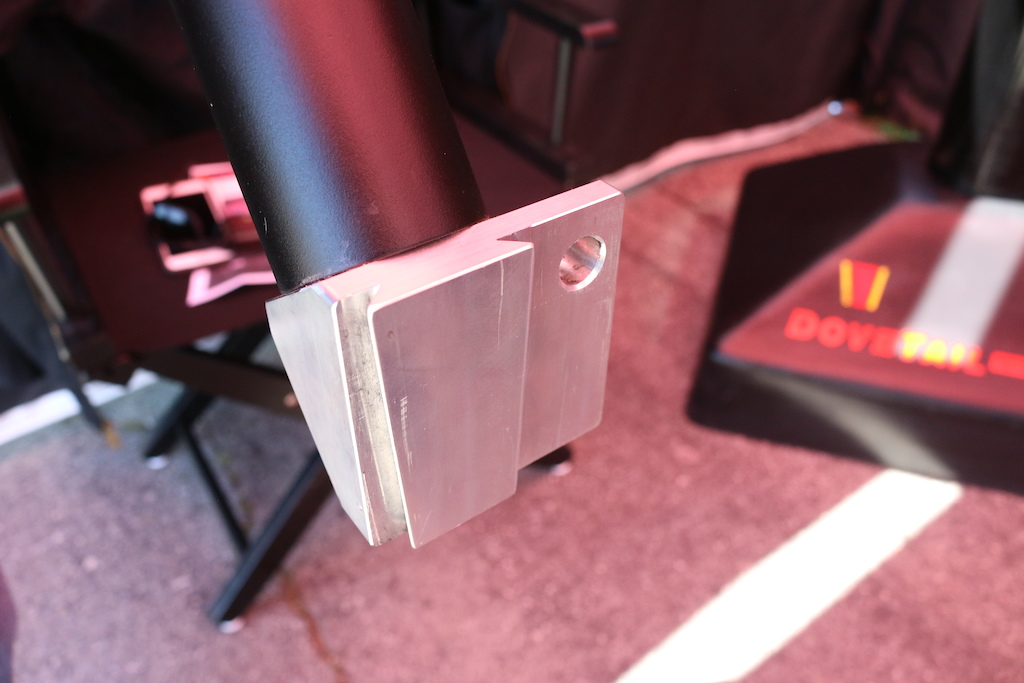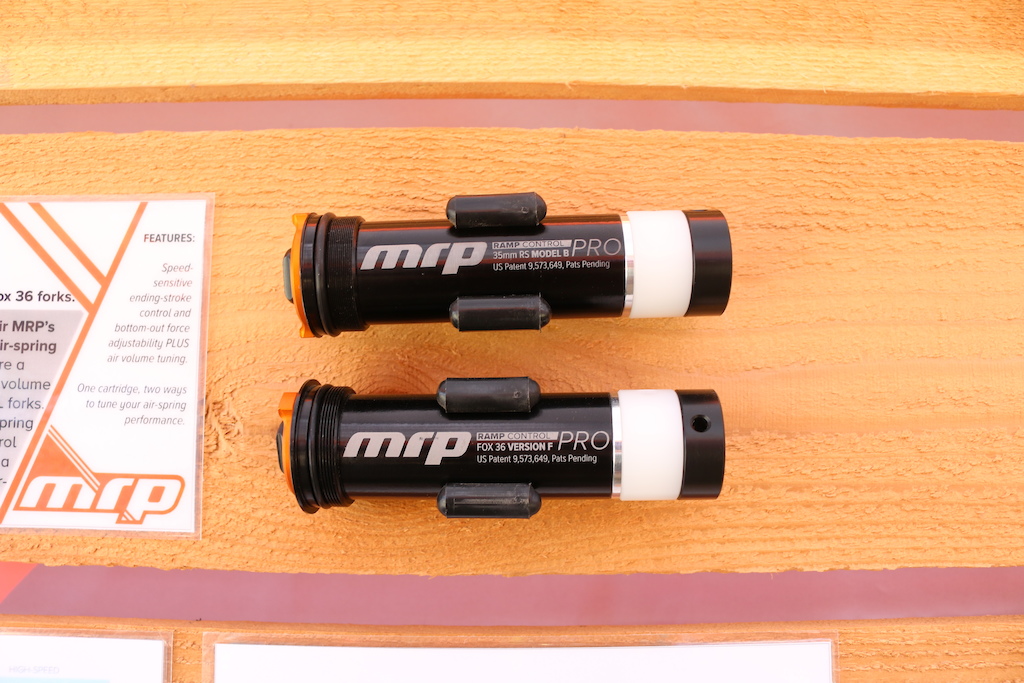MRP's Ramp Control Pro Cartridge, Carbon Repair Service, & a 13 LB Bike Rack - Sea Otter 2019
At just 13lb, the DoveTail rack weighs a fraction of some other options out there.
Short of a tailgate pad on the back of your truck, tray-style hight-mount racks are pretty much the way to go for a lot of us, and most of them are similar. The lightweight DoveTail rack includes a few tricks, though, especially how it attaches to the back of your vehicle. It takes its name from the dovetail joint at the hitch, with the female half being bolted into the receiver. The male half of the joint is on the rack, and you simply slide it down into the hitch and let the weight of the rack (and bike) tighten the joint.
In fact, it gets so snug that the rack comes with a short prybar-style tool that you push through an opening on the opposite side to knock the rack loose.
The DoveTail rack attaches to your car via a dovetail joint.
The other notable point is how the rack grabs onto your bike: By the crankarm. A slotted vertical post sits in the middle of the rack, and all you do is put your non-drive-side crank at the 6-o'clock position and lower it down into the post. The pedal fits through a slot, and there's a dial (with a padded head) on the opposite side that you turn down against the crankarm to snug it up. The edges of the slot are padded, too, and there's a C-shaped plastic bushing at the top.
The whole thing is aluminum and is said to weigh just 13lb, which is much lighter than most other racks and no-doubt helped by the fact that each tray only needs to worry about the front wheel. It'll work with bikes up to 48'' long, crankarms between 165 and 180mm (no kids bikes!), and 2.5'' wide front tires. All that costs $395 USD.
Your bike is held in place by slotting the crankarm down into a hollow vertical post. A dial on the backside can be tightened to keep it from rattling around.
MRP's Ramp Control Pro cartridge offers both speed-sensitive and position-sensitive ending-stroke control.
MRP's Ramp Control cartridge works because air is a mixture of gasses that, while extremely thin, will still put up some resistance when forced through an extremely small hole or port at a high rate of speed. Picture it being similar to how oil is forced through ports and shims to provide damping, and if you go back far enough you'll find simple dampers that used air rather than oil.
Adjusting air volume to tune ramp-up usually means changing the physical volume of the air chamber by turning a dial to move a piston up or down, or by adding volume-reducing tokens.
Ramp Control takes a different approach, with an anodized orange knob that adjusts the preload on a small port at the bottom of the cartridge. More preload means more force is required for air to enter the cartridge, supplying you with more bottom-out resistance. Less preload allows air to transfer from the fork's normal air chamber and into the cartridge easier, so you'll have less ramp-up.
The new Ramp Control Pro offers the same speed-sensitive ending-stroke control, but MRP has added threads to the bottom of it that accept their Huck Puck volume-reducing tokens as well, thereby giving it position-sensitive control to boot.
The new Ramp Control Pro offers the same speed-sensitive ending-stroke control, but MRP has added threads to the bottom of it that accept their Huck Puck volume-reducing tokens as well, thereby giving it position-sensitive control to boot.
Break your favorite carbon frame? Joe's Carbon Solutions might be able to fix that.
Break your fancy carbon bike that you bought used? Old Faithful manage to hold out until it's a decade out of warranty before cracking a chainstay? Joe's Carbon Solutions can probably help you out. They've been repairing carbon fiber since 1989, long before the stuff was being widely used to manufacture bicycles, and they claim to have saved more than 9,000 over the last thirty years. It's a full-service outfit, too, with re-painting, graphics, and clearcoats all done in-house.
Not every frame can be brought back from the dead, though, and Joe's has a few different methods depending on the type of failure. A broken seatstay might call for a wrap of carbon, whereas an impact hole would require a carbon patch, and some need internal reinforcing before being ridable again.
The obvious question is: What about broken carbon rims. The answer is "maybe," depending on how it failed. A crack at one of the spoke holes needs a patch over it before being re-drilled for the spoke and nipple, but things get a lot more complicated as you get closer to the rim's bead. A nasty rock strike that causes that kind of crack likely isn't fixable.
The obvious question is: What about broken carbon rims. The answer is "maybe," depending on how it failed. A crack at one of the spoke holes needs a patch over it before being re-drilled for the spoke and nipple, but things get a lot more complicated as you get closer to the rim's bead. A nasty rock strike that causes that kind of crack likely isn't fixable.
Author Info:
Must Read This Week
How to Watch the 2024 Mountain Bike World Cup [Update: Staylive Offering Access in New Zealand, South Africa & More]
60223 views
60223 views
[UPDATED] Final Elite XC Results & Overall Standings from the Mairiporã XC World Cup 2024
41167 views
41167 views
Sign Up for the Pinkbike Newsletter - All the Biggest, Most Interesting Stories in your Inbox
PB Newsletter Signup










Step 2: develop a solution (crank arm holding front wheel tray rack with dove tail mounting solution)
Step 3: determine cost to cover manufacturing solutions and pay your salary ($395 should cover it and plenty of days to ride)
Step 4: Ignore or forget that the market has numerous perfectly suitable bike racks for less than half your product cost including two American made aluminum racks for less than $350 and the vast majority of your potential customers have no interest in messing up their very expensive cranks as evident by your using an very old cheap bike to demonstrate your product.
Dont get me wrong, new innovations are cool, but sometimes you gotta consider price and market saturation for those innovations.
However, most air forks use a port on the stanchion (like Rockshox Solo Air), so there is some travel that isn't back by any force. Rockshox dual air was very sensitive and was always better with more air in the negative chamber to reduce spring preload to zero. Manitou's setup acheives the same by simply pulling the fork slightly into its travel with a pump attached- a pump on the valve opens both air chambers at once. It pops right back to full travel after that.
The whole thing makes massive sense for larger riders or big hitting riders who lose small bump sensitivity by using high pressure.
What I'm suggesting is that it shouldn't really be thought of as running more pressure in one chamber than the other. Adding more air to the negative will pull the fork into its travel until (assuming a friction free setup) the forces acting on wither side of the piston equalise. It won't sit there at the same travel as before but with unequal spring pressures. It will compress, which gives you a shorter travel fork with the same travel air spring. This *might* give you a nicer spring curve, depending on the various design specifics of the spring you are running. And the number of tokens you have added, etc. It's not as simple as "adding more negative volume at the expense of overall travel will make your fork better."
The pressure equalises through the swap bump. Yet the piston does not magically move if the swap bump is sealed....this doesnt fit with your theory. You have made a mistake somewhere..
You can tell which stories are reviews because they're titled "Review: (...)".